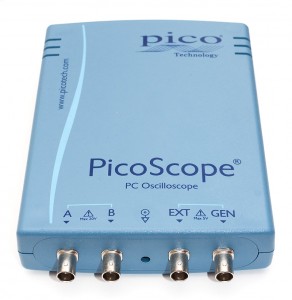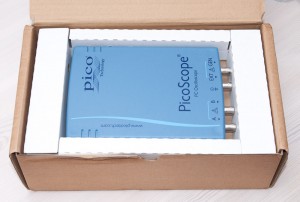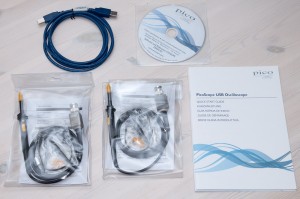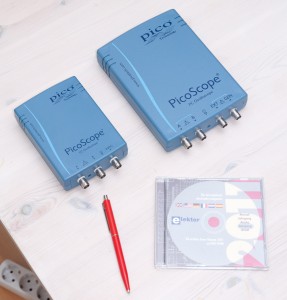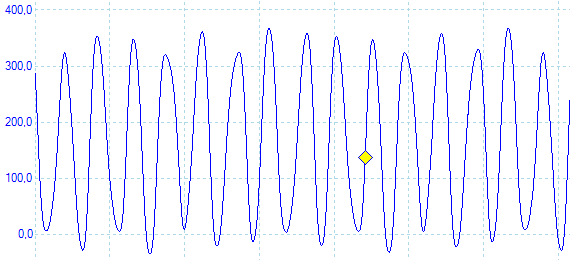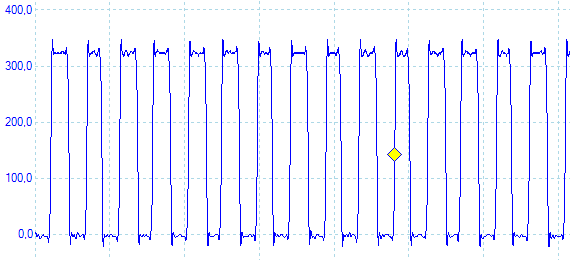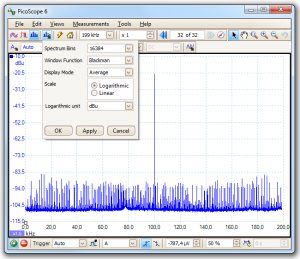PicoScope 3206B Review
As I mentioned earlier, I got a PicoScope 3206B back in August. After a few months of use I have gathered enough experience with it to feel qualified to write a review on the device.
Those who haven’t yet done so, I suggest you to check out my earlier review of PicoScope 2204 – it covers a bit of my rationale for a USB scope, and the basic features of Picoscope software, which is the same for the whole PicoScope product line.
The 3206B is the top-of-the-line two-channel scope in the 3000 series. The prices have dropped a bit after the introduction of mixed signal version 3206B MSO, so for $1320, you’ll get this device with fairly impressive key feature set:
- Two channels, and external trigger line
- 200 MHz analog bandwith
- 500 MS/s sampling rate
- A huge 128 MS sample buffer
- Arbitary waveform function generator (20 MS/s)
- Two 250 MHz probes, storage bag and software CD
For full details, I suggest you to look up the 3200 series spec sheet from Picotech’s website. Let’s get started!
Unpacking the box
Picotech ships from UK and within EU, no additional taxes or import fees need to be paid. Both my deliveries from them have arrived promptly within two days, well packaged and in impeccable condition.
The scope comes in a cardboard box that also has space for the probes, a storage bag and software CD. Nothing too fancy, but works well for longer term storage, too.
The probes have a quality feel to them, and come with a detachable hook end that is quite useful for grabbing jumper wires and such. Of course for high frequency measurements, just the probe tip is recommended, because I learned the hard way even small additional pieces of wire have a surprising amount of capacitance that can distort a 25 MHz signal.
There’s also a software CD, although you can download the latest version of PicoScope software from Picotech’s site and avoid one update.
Installation is basically plug and play – once you have the drivers and PicoScope software, just plug the device in, wait for it to be recognized and fire up the program. It even works in 64 bit Windows 7 very well. I also believe Linux drivers are available if you want to use the SDK.
3206B compared to 2204
As a owner of PicoScope 2204, I was surprised how much larger the 3206B is. Still, both are fairly light and don’t take much space on desktop. However, the 3206B isn’t “almost pocket sized” anymore, although it’ll easily fit into a laptop carrying bag to take on the go if needed. You’ll get a good idea from the picture on the right (click for a larger version).
Specification-wise, the 3206B one-ups almost every specification – the functionality is pretty similar, but the 3206B usually has it ten times more. A quick rundown of 3206B vs. 2204 features:
- 250 MHz vs. 10 MHz bandwith (25x)
- 500 MS/s vs. 100 MS/s sampling rate (5x)
- 128 MS buffer vs. 8 kS (16 000x)
- 20 MS/s vs. 2 MS/s waveform generator (10x)
- External trigger vs. no ext. trigger
Naturally, the increased bandwith comes with greater range of timebases and rise time values. Besides specs, the handling and use is pretty much identical – there’s nothing additional to learn when upgrading to 3206B, and as the software is the same, the biggest change is that the timebases now go up to 2 ns / div compared to 100 ns / div with the 2204. Below you can see how the ~22 MHz signal from my Raspberry Pi GPIO benchmark looks really round in 2204 (the waveform is still approximated with correct frequency, which is still quite an achievement for a scope with 10 MHz nominal bandwith):
You cannot do much analysis on the result above, as the frequency is just too high for the 2204. On the other hand, PicoScope 3206B has no trouble with these speeds (actually the wire I used to ground the probe is a bigger issue than the scope capabilities):
If you have both scopes connected, you can launch two instances of PicoScope software and the first instance will ask on startup which device to use (the second will default to the one left free). However, you cannot use both scopes from one instance, so 4-channel serial decoding for example is unavailable.
PicoScope software
Being a USB scope, the main tool to work with the device is the oscilloscope software. For Picotech, this software is called PicoScope like the scopes themselves, and the program is freely available on the website which can also function in demo mode. The basic interface is very Windows-like, with dropdown menus to select timescales, trigger modes etc. There’s no additional eye candy in the UI, like shaded knobs, cool displays or shaded, rounded rectangles. Instead, it’s very much “no frills, straight to business” type of application with a very simplistic UI which doesn’t get into your way when looking at waveforms.
There is a lot of advanced functionality under the hood – you can add complex math channels, configure the views to your liking, and measurements, do serial decoding etc., but it’s all arranged so that it doesn’t eat up the screen estate. On my 2560×1600 desktop this isn’t so important, but for a laptop it very well might be. The UI might be a bit boring, but that is mainly in a good way – it doesn’t get between you and the signal you are analyzing. And after almost a year of use, I haven’t yet found any significant functionality missing (and as discussed below, special needs are nicely met through the SDK).
Arbitrary function generator (AWG)
One of the nice features of the 3206B is the 1 MHz arbitrary wave form generator, which allows the generation of the standard sine, square, sawtooth etc. signals as well as white noise, as well as custom waveforms. With custom I mean that you can import a self-made waveform (it’s limited to 16 kS for a waveform, so no recorded television signals or such, though) and have the generator to play it back repeatedly. Also sweeps are supported which might be useful for analysis purposes.
The 1 MHz, 20 MS/s limit means that it won’t replace a dedicated unit in serious use, but it’s definitely enough for most hobbyists.
Spectrum Analyzer
With a PC-based scope, it’s easy to do spectrum analysis from the captured scope data. I’m not an expert in this field, so I’ll limit my comments to the fact that it seems to work nicely, in real time, and offers quite a few configuration options. It’s definitely a nice feature to have. As a future improvement point for Picotech, it would be nice to see a similar “persistence mode” for the spectrum analyzer that would accumulate tens or even hundreds of measurements for a nice visual “spectrum profile”.
Actually, once I got this idea and was taking a screenshot, I realized the software actually does have an averaging mode. Very nice! On the right you can see a 100 kHz test sine wave from the AWG being tested. Quite good performance, as the harmonics are a lot better than many of my AVR signal generator tests.
Serial decoding, persistence mode
Since I covered the serial decoding and persistence mode in my 2204 review already, I’ll skip those this time. Read my previous review if you are interested in those.
3000 series SDK (software development kit)
In addition to being a capable piece of hardware backed up with clean PC side software with professional grade features, the PicoScopes shine on a third front: You can easily set them up to capture data, save it to disk, or access any of the scope’s features from a plethora of programming languages (C, C#, C++, Delphi, Excel, LabVIEW, VEE, and Visual Basic are listed on SDK download page).
I’ve only tried out the C, and while the API documentation could be even better, the API is quite straightforward and the documentation does enough to explain the steps and functions needed to achieve different things. And once you have the data capture code written, only the sky’s the limit what you can do with it. For one cool example, I wrote a NTSC composite signal decoder that uses the PicoScope 3206B to capture a few million samples from Raspberry Pi composite video output, and decode and display the picture from the Pi in realtime. See my article for full details, the example video is shown below:
The 128 MS buffer size is also a huge step up. You can capture a full second at 100 MS/s and still have buffer to spare! It’s easily enough for almost any purpose, and after using the 3206B it would be hard to go back to the USB scopes that only have a few kilosamples of memory.
Possibilities for improvement
From a hobbyist perspective, PicoScope 3206B is a product that doesn’t have much that needs to be improved upon. Sure, it would be nice to have 1 GHz analog bandwith, but would I ever use it? Apart from viewing a clock signal from a modern ARM microcontroller (which isn’t very useful endeavor), the more limiting factor currently sits between the chair and the computer. Four channels is actually the thing I miss the most, but even that is largely because I would like to use the PicoScope for I2C serial decoding as I don’t have logic analyzer at hand (so the 3206B MSO version would be a logical upgrade if I’d consider my needs today).
So hardware-wise, I cannot find much anything to fault. The only bigger issue is the fact that the scope ground is connected via USB to the PC ground, so the scope is not actually floating, and it cannot be used to measure signals with different ground level without a separate differential probe. Also, the voltage ranges (+-20V max) might be a bit limiting for some purposes. But also these can be solved with attenuators. And of course, the 8 bit sampling accuracy might always be higher (the 12 bit versions carry a significant price premium in the PicoScope 4000 line and their bandwith is limited to 100 MHz)
On the software side, the PicoScope application is very powerful, and I haven’t yet found any critical feature that is missing. Perhaps the continuous capture, use of PicoScope buffer (for some reason it’s hard for me to grasp how the software is actually using the 128 MS buffer) and saving captured data to disk could be clarified a bit.
Also, it would be interesting to see if the somewhat “early 2000” approach to the GUI could be replaced with something akin to what Adobe has done with Lightroom, and how many music and video editing software approach the user interface – maybe instead of popup windows and dialogs, the UI could have control panels that could be hidden or shown when needed, strips of previews for waveform buffer, and some combination of mouse/wheel and keyboard shortcuts that could be used to change time scales and zoom in and out of the signal – it might add a bit of “wow” effect to the UI, and speed up the workflow further when using the excellent scope.
Finally, something for the Picotech people to consider: How about making a separate “USB control panel” with a few knobs for the most used settings of the scope, that could be placed independently from the scope (e.g. under the monitor) to quickly tune the most important settings? The software already has great facilities to customize keyboard shortcuts, so with small additions, these bindings could be extended to a physical device.
Conclusions
After three months of use, I can say that the PicoScope 3206B seems to have all the good parts of the 2204 I’ve used earlier (only drawback being the slightly larger size and bigger price tag), but with the specs of a serious benchtop scope. While it doesn’t have the knobs and controls a benchtop scope has, the PicoScope form factor beats them hands down, and nothing can match a good PC display for viewing waveforms. So to summarize:
Pros
- Small and well built
- Excellent 250 MHz bandwith, 1 GS/s
- Large 128 MS buffer
- Versatile, easy-to-use software with regular updates
- Advanced SW features such as serial decoding and spectrum analysis
- Waveform generator, external trigger
- Very good SDK enables writing custom software for the scopes
- Comes with 250 MHz probes
- Fast delivery, good customer service and 5 year warranty
Cons
- Limited voltage range (-20..20V without use of attenuators)
- Ground coupled to PC via USB (separate differential probes, USB isolator or laptop running on battery required to work around)
- USB 2.0 limits streaming data capture rate and slows down transfer of large captures
- Scope controls in UI don’t benefit from a large display
Overall, I can warmly recommend the PicoScope 3206B, as it sure packs a punch for its price. If you’re looking for your first scope, be sure to also check out the 2000 series (and my 2204 review). But if you want a bit more and are prepared to invest for a serious scope, you cannot go wrong with the 3000 line. Also consider if you’re willing to spend a bit extra to get either the MSO version that contains 16 digital lines, or the 34xx models with four channels – there are definitely options in the Picotech’s lineup to suit any wallet. :)
